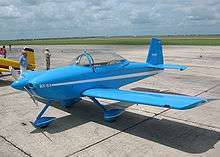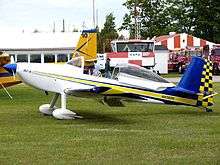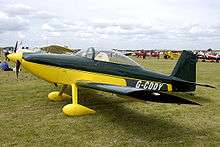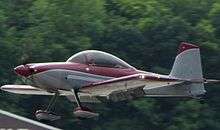Van's Aircraft RV-8
| RV-8 | |
|---|---|
 | |
| Role | RV-8 |
| Manufacturer | Van's Aircraft |
| Designer | Richard VanGrunsven |
| First flight | 1995[1] |
| Introduction | 1995[1] |
| Number built | 1272 (November 2014)[2] |
| Unit cost |
USD$ 41,000–98,000 |
| Developed from | Van's Aircraft RV-4 |






The Van’s RV-8 is a tandem two-seat, single-engine, low-wing homebuilt aircraft sold in kit form by Van's Aircraft. The RV-8 is equipped with conventional landing gear, while the RV-8A version features tricycle landing gear. The design is a larger development of the RV-4, and is similar in appearance, although larger, than the earlier model.[3][4][5]
Development
Richard VanGrunsven designed the RV-8 series as an improved RV-4, itself a two-seat version of the single seat RV-3. The RV-8 first flew in 1995 and was first shown publicly at Oshkosh that year.[1]
The RV-8 incorporated changes as a result of lessons learned in producing the popular RV-4 design. The RV-8 airframe will accept larger engines, including the Lycoming IO-360, up to 200 hp. The RV-8 also has increased wingspan and wing area over the RV-4, as well as more cockpit width, headroom, legroom and an increased useful load, all with a view to accommodating larger pilots. Like the RV-3 to RV-7 that preceded it, the RV-8 is stressed for aerobatics.[1][5]
The RV-8 shares many common parts with the RV-7 and RV-9 which reduces production costs. Like the RV-7, the RV-8 uses computer assisted design to produce a kit with pre-drilled rivet holes, thus greatly reducing assembly time for the builder.
The RV-8 was intended from the start to have a nose-gear stablemate designated the RV-8A. The RV-8A was first flown in 1998 and features tubular steel landing gear with the nosewheel mounting tube welded to the engine mount. As in all nose-wheel equipped RV aircraft, the nosewheel is free castering and the aircraft is steered with differential braking. The brakes are mounted conventionally on the rudder pedal toes.
By November 2014, 1272 RV-8s and RV-8As were flying.[2]
Specifications (RV-8)
Data from Van's Aircraft[6][7]
General characteristics
- Crew: one
- Capacity: one passenger
- Length: 21 ft 0 in (6.40 m)
- Wingspan: 24 ft 0 in (7.32 m)
- Height: 5 ft 7 in (1.70 m)
- Wing area: 116 sq ft (10.8 m2)
- Empty weight: 1,120 lb (508 kg)
- Gross weight: 1,800 lb (816 kg)
- Fuel capacity: 42 U.S. gallons (160 L; 35 imp gal)
- Powerplant: 1 × Lycoming IO-360 four cylinder, horizontally opposed piston aircraft engine with fuel injection, 200 hp (150 kW)
Performance
- Maximum speed: 221 mph (356 km/h; 192 kn)
- Cruise speed: 210 mph (182 kn; 338 km/h) at 75% power at 8000 feet
- Stall speed: 58 mph (50 kn; 93 km/h)
- Range: 940 mi (817 nmi; 1,513 km) at 55% power and 8000 feet
- Service ceiling: 22,500 ft (6,858 m)
- Rate of climb: 1,900 ft/min (9.7 m/s)
- Wing loading: 15.5 lb/sq ft (76 kg/m2)
See also
- Related development
- Aircraft of comparable role, configuration and era
References
- 1 2 3 4 "Total Performance RV Kit Planes". Van's Aircraft. Retrieved 2012-08-21.
- 1 2 "First Flights". Van’s Aircraft. 5 April 2013. Retrieved 5 April 2013.
- ↑ Downey, Julia (December 2007), "Kitplanes", 2008 Kit Aircraft Directory, 24 (12), Primedia, p. 77, ISSN 0891-1851.
- ↑ Vandermeullen, Richard: 2011 Kit Aircraft Buyer's Guide, Kitplanes, Vol. 28, No. 12, December 2011, p. 74. Belvoir Publications. ISSN 0891-1851
- 1 2 Bayerl, Robby; Martin Berkemeier; et al: World Directory of Leisure Aviation 2011–12, p. 125. WDLA UK, Lancaster UK, 2011. ISSN 1368-485X
- ↑ "Van's Aircraft - RV-8 Specifications". Vansaircraft.com. Retrieved 2012-08-21.
- ↑ "Van's Aircraft - RV-8 Performance". Vansaircraft.com. Retrieved 2012-08-21.
External links
| Wikimedia Commons has media related to Van's Aircraft RV-8. |